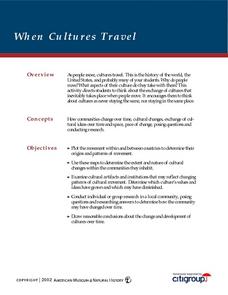Curated OER
Happy Thankgiving: Traditions in Culture
Students relate their own Thanksgiving experiences to those of the past through colonial games, Thanksgiving story books, and personal interviews. They develop a concept of how to celebrate Thanksgiving and plan a class time celebration,...
Curated OER
The Alphabet is Historic
Young scholars describe how the Phoenicians, Greeks and Romans passed down the alphabet through the generations. They compare and contrast the letters from early alphabets to the one of today and discuss how they are different. Using a...
Curated OER
Quarter System
Students participate in class discussions, study vocabulary, study culture and complete workbook activities. Students then display knowledge of cultural criteria through assessment.
Curated OER
Dolls Around the World - Figurative Sculpture
Students examine different cultures while making doll sculptures. Using tinfoil, they make the doll, paint them and give them hair and props related to that specific culture. They also compare and contrast different dolls as they...
Curated OER
Paper Masks/Heads
Learners examine the processes and beliefs used by different cultures to create works of art. Using the internet, they research the types of arts used by cultures that have been transmitted to future generations. They use recycled...
Curated OER
Haiku and Beyond: Exploring Genres of Japanese Literature
Fourth graders compare and contrast the literature of Japan as they study the culture, history and geography of the island nation. They read various genres of literature, describe geographic and landform features of Japan, and find...
Curated OER
Journey to Japan: An Elementary Geography Standards-Based Unit on Japan
Second graders compare and contrast Japanese customs and culture to those of Americans through research in this year long study. They determine the basic needs of all people in spite of cultural differences.
Curated OER
Playing the Cardboard Dulcimer
Second graders create cardboard dulcimers. They discover that sound is produced by vibrating strings and analyze the pitch produced by changing the sizes and length of the strings of the instrument. They also discuss the history of the...
Curated OER
Japan: Yesterday and Today
Students study the geography and culture of Japan and discover important historical events. They look at the religions of Japan. They determine similarities and differences in the lives of teenagers in Japan and the US. They read and...
Curated OER
In Perfect Harmony: Teaching the World to Sing
First graders listen to music as the impetus to learn about the concept of Japanese harmony as it is understood in Japanese culture. They use the New Seeker's song, "I'd Like to Teach the World to Sing," to compare America and Japan...
Curated OER
Immigration Explorations, Part 2
Students conduct secondary source research using the internet and library resources to learn more about the backgrounds of their family's cultural and ethnic heritages. Students can work together in research groups that have common...
Curated OER
Teaching Hmong History And Culture Through Story Cloths
Students examine the culture and history of the Hmong. Using story cloths, they investigate how they were used as expressions of their culture. They discover the Hmong's economic conditions and how they were able to form a new way to...
Curated OER
Native American Village Days
Students research the tribes of American Indians in Virginia and settled, agricultural tribes in other regions of America. They explain how geography and climate influenced the way various Indian tribes lived, and evaluate the impact of...
Curated OER
Timucuan Pottery
Students study the culture and time period of the Timucua in Florida. They design pottery and a group dramatization of the daily life of The Timucua.
Curated OER
Cultures Around the World
Students research, using the Internet, cultures of the world. They identify countries, their currency, holidays, climate and societal information. They look at the distance of international cities from their hometown.
Curated OER
Cultures Around the World
Learners examine the types of celebrations around the world. They create pictures of animals speaking another language than their own and draw flags of countries around the world. They also retell a folktale to their classmates.
Curated OER
Cultures
Young scholars research different cultures around the world. They discover that each culture is a way to express oneself. They compare and constrast how different cultural events are celebrated and draw their own conclusions about them.
Curated OER
Cultural Diversity
Students examine their relationships to cultural groups and make conclusions about their diverse roles in different cultures. They decide why people play multiple roles in society while creating a cultural treasure chest.
Curated OER
How Cultures Travel
Students examine how people and cultures have moved over time. They plot the movement of different groups of people and examine any cultural artifacts. They research a local group of people to determine how their community has changed...
Curated OER
Artifacts
Students examine different artifacts and determine the difference between personal and cultural objects. They collect items from their home of cultural importance as well. They identify all they can from artifacts they are given to analyze.
Curated OER
Cultures for Elementary Students
Students research one or more cultures. They determine what aspects of the culture to research based on their interests. They develop a research proposal and share it with the class.
Curated OER
Stereo What?
Students define words associated with stereotypes. They identify the difference between stereotype, prejudice and discrimination and give examples of each. They discover their own personal biases.
Curated OER
Cultures
Students examine and analyze photographs of other cultures. They answer discussion questions, identify bias and point of view in the images, conduct research on another photo, and compare and contrast two cultural images.
Curated OER
Comparing Cultures
Students examine the nature of culture, and compare/contrast various cultures and their artifacts and ceremonies. They develop a class list of artifacts, complete a worksheet, and create a poster or diorama describing an object that is...

























